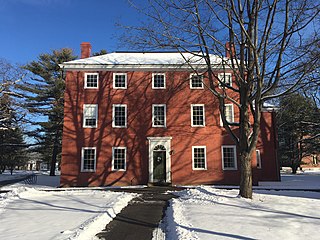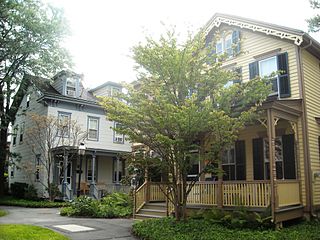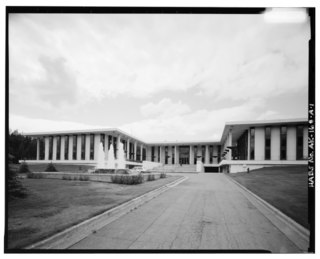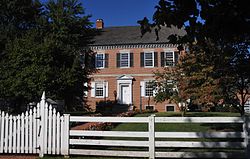
Dover is the capital and second-most populous city of the U.S. state of Delaware. It is also the county seat of Kent County and the principal city of the Dover metropolitan statistical area, which encompasses all of Kent County and is part of the Philadelphia–Wilmington–Camden, PA–NJ–DE–MD, combined statistical area. It is located on the St. Jones River in the Delaware River coastal plain. It was named by William Penn for Dover in Kent, England. As of 2020, its population was 39,403.

Delaware State University is a privately governed, state-assisted historically black land-grant research university in Dover, Delaware. DSU also has two satellite campuses: one in Wilmington and one in Georgetown. The university encompasses four colleges and a diverse population of undergraduate and advanced-degree students. Delaware State University is classified among "R2: Doctoral Universities – High research activity".

The Rotunda is a building located on The Lawn on the original grounds of the University of Virginia. Thomas Jefferson designed it to represent the "authority of nature and power of reason" and modeled it after the Pantheon in Rome. Construction began in 1822 and was completed shortly after Jefferson's death in 1826. The campus of the new university was unique in that its buildings surrounded a library rather than a church, as was common at other universities in the English-speaking world. To many, the Rotunda symbolizes Jefferson's belief in the separation of church and education, and represents his lifelong dedication to education and architecture. The Rotunda was designated a National Historic Landmark in 1966, and is part of the University of Virginia Historic District, designated in 1971.

Urbana University was a private university specializing in liberal arts education and located in Urbana, Ohio. In its final few years, it was purchased by Franklin University and was a branch campus of that university.

Marycrest College Historic District is located on a bluff overlooking the West End of Davenport, Iowa, United States. The district encompasses the campus of Marycrest College, which was a small, private collegiate institution. The school became Teikyo Marycrest University and finally Marycrest International University after affiliating with a private educational consortium during the 1990s. The school closed in 2002 because of financial shortcomings. The campus has been listed on the Davenport Register of Historic Properties and on the National Register of Historic Places since 2004. At the time of its nomination, the historic district consisted of 13 resources, including six contributing buildings and five non-contributing buildings. Two of the buildings were already individually listed on the National Register.

Pfeiffer University is a private university in Misenheimer, North Carolina. It is affiliated with the United Methodist Church.

The Roger Hadfield Ogden Honors College is an academic community at Louisiana State University. Housed in the heritage-listed French House, it was founded in 1992 as the LSU Honors College, and renamed in December 2014. The college primarily admits the top 10% of incoming LSU freshmen, and provides its students with a curriculum of seminar classes, mentoring relationships with faculty, and opportunities for undergraduate research, culminating in the Honors Thesis.

Albion State Normal School was a public institution of higher learning the western United States, located in Albion, Idaho. Established by the Idaho Legislature in 1893, it was one of two normal schools in the state. Citizens of Albion had actively lobbied for the school's establishment, and donated land and labor for the new campus.

The Main Building of Vassar College is the oldest surviving building on its campus in Poughkeepsie, New York, and the center of academic life. It was built by James Renwick, Jr. in the Second Empire style in 1861, the second building in the history of what was one of America's first women's colleges. It is one of the earliest, largest, and most important examples of Second Empire architecture in the United States and is a National Historic Landmark for its architecture and educational significance. At the time of its completion, the structure contained the most interior space of any building in the United States, and housed the entire college, including dormitories, libraries, classrooms, and dining halls. Currently, the first and second floors house campus administration while the remaining three house student rooms.

First State Heritage Park is Delaware's first urban "park without boundaries" linking historic and cultural sites in Dover, Kent County, Delaware, the city that has been the seat of state government since 1777. It is a partnership of state and city agencies under the leadership of Delaware State Parks. Delaware was the first state to ratify the United States Constitution. The sites of the park highlight Delaware's role as the First State. First State Heritage Park is open year-round, with special tours of the sites given the first Saturday of each month.

Massachusetts Hall is the oldest building on the campus of Bowdoin College, in Brunswick, Maine. It was built 1798–1802, and has seen a number of uses during the school's long history. The building was listed on the National Register of Historic Places in 1971.
The University of Arkansas Campus Historic District is a historic district that was listed on the National Register of Historic Places on September 23, 2009. The district covers the historic core of the University of Arkansas campus, including 25 buildings.

The History of Louisiana Tech University began when the Industrial Institute and College of Louisiana was founded in Ruston, Louisiana in 1894. The institute was founded to develop an industrial economy in the state of Louisiana. Four years later, the school was renamed the Louisiana Industrial Institute when Louisiana adopted the Constitution of 1898. When the Constitution of 1921 was passed, the school changed its name again to Louisiana Polytechnic Institute to reflect the school's evolution from a trade school into a larger and broader technical institute. Although the university was informally called Louisiana Tech for about five decades after the 1921 name change, it was not until 1970 when Louisiana Polytechnic Institute officially changed its name to Louisiana Tech University. Over the course of its history, the school grew from a small industrial institute with one building to a university with five colleges and an enrollment of around 11,800 students.

Starkweather Hall, also known as Starkweather Religious Center, is a religious and educational building located at 901 West Forest Avenue in Ypsilanti, Michigan, on the campus of Eastern Michigan University. It was designated a Michigan State Historic Site in 1972 and listed on the National Register of Historic Places in 1977. It is also part of the Eastern Michigan University Historic District and is the oldest building on EMU's campus.

The Edwards Gymnasium and Pfeiffer Natatorium on the main campus of Ohio Wesleyan University was built in 1905. It was designed by architect J.W. Yost and was built by Feick & Son.

Bradford-Loockerman House, also known as the Loockerman House, is a historic home located at Dover, Kent County, Delaware. The house is in two sections; one of brick and one frame. The original section dates from 1742 and is a 2+1⁄2-story, brick, nearly square five bay structure in a First Period English(late-Medieval) / early-Georgian style. Attached is a substantial later frame addition. It fronts directly on the sidewalk with no front dooryard, but has a large and very handsome garden behind the main house and on its south side.

The Princeton Historic District is a 370-acre (150 ha) historic district located in Princeton, New Jersey that was listed on the U.S. National Register of Historic Places in 1975. It stretches from Marquand Park in the west to the Eating Clubs in the East, from the Princeton Cemetery in the north to the Graduate College in the south. The district encompasses the core parts of the campuses of the Princeton Theological Seminary and Princeton University. It also includes the business district centered on Nassau Street and many historic homes, both mansions in the western section and more humble dwellings in the Witherspoon/Jackson neighborhood. Notable churches within the district include Nassau Presbyterian Church, Trinity Episcopal, Nassau Christian Center, and the Princeton University Chapel. The district is home to seven of Princeton's nine, and New Jersey's fifty-eight, National Historic Landmarks, the largest concentration of such sites in the state.

The Atwood Campus Center is the student center of Alaska Pacific University in Anchorage, Alaska. It is a two-story square building 113 feet (34 m) on each side, elevated on a podium extending ten or more feet to each side. It is flanked by two residence halls, which, although also 25 feet (7.6 m) in height, have three stories. This complex was designed by Edward Durell Stone and built in 1966, when the school was known as Alaska Methodist University. This complex has been listed on the National Register of Historic Places for its significance as the site of a major 1971 conference of more than 600 Alaska Native representatives, at which they formally accepted the Alaska Native Claims Settlement Act, landmark legislation which fundamentally altered the handling of land ownership and use in the state, particularly with respect to native title, which had long clouded many real estate transfers.

University Hall is the main academic building at the Ohio State University in Columbus, Ohio. The building houses classrooms for several of the university's colleges and includes a museum on the ground floor.






















